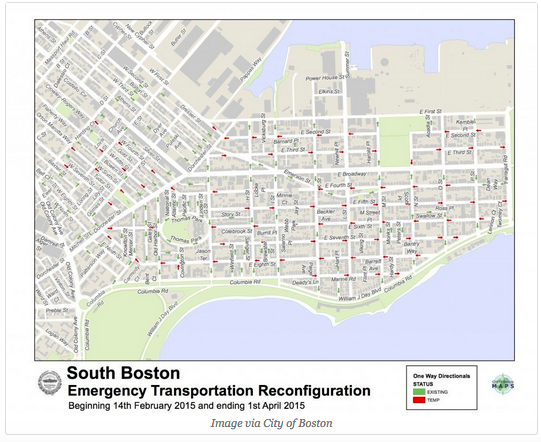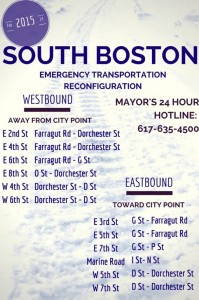
Update: The following public meetings have been scheduled to discuss the future of the South Boston Emergency Transportation Reconfiguration with residents:
April 28, 2015, 6:30 p.m.
Condon Elementary School
200 D Street
May 6, 2015, 6:30 p.m.
Tynan Elementary School
650 E 4th Street
Update: Mayor Walsh announced Tuesday the South Boston Emergency Transportation Reconfiguration (ETR) will be extended through June 1, 2015. Said the mayor:
We’ve received a tremendous amount of positive feedback from South Boston residents about how the emergency reconfiguration has relieved traffic congestion and increased public safety. I look forward to engaging in a robust discussion with the community on the future of these neighborhood streets.
Earlier: When the City of Boston opted to make some of South Boston’s roads one-way in February, they really only needed it to last as long as the snowbanks were around. But the results of an informal poll conducted by the South Boston blog Caught in Southie show that a majority of residents may actually want to keep those streets one-way, despite the reconfiguration expiring on April 1st.
The City originally made the decision based on resident feedback on how to stem the congestion back on February 14. The reconfiguration worked especially well for Southie because it’s one of Boston’s few gridded neighborhoods; it’s wieldier to enforce and easier to remind drivers that even-numbered streets run west and odds run east.

But reconfiguration also inadvertently fixed one of South Boston’s other problems: the lack of surface parking spaces. Having a two-way configuration on already narrow streets sacrifices precious room for what might just be marginal convenience. A Caught in Southie post examined this:
To be honest, when the streets are two-way, it’s not like you can cruise down them comfortably without a care in the world. They are pretty tight and you if you add to the mix a double-parked car – or worse people double-parking like jerks on both sides of the street – they are tough to navigate. So why not make them one-way?
So if we’re keeping the one-way, there could be enough room to drop in angled rather than parallel parking spaces.
While the poll shows, at the time of this writing, that 64 percent of voters supported keeping the streets one-way, City Council President Bill Linehan of South Boston told the Boston Globe that the configuration doesn’t work on every street, but residents have approved of the increased sense of order even where there wasn’t snow.
The City Council hasn’t made a decision as to whether or not to keep the reconfiguration going or not, but if they do, we’ll update here.
